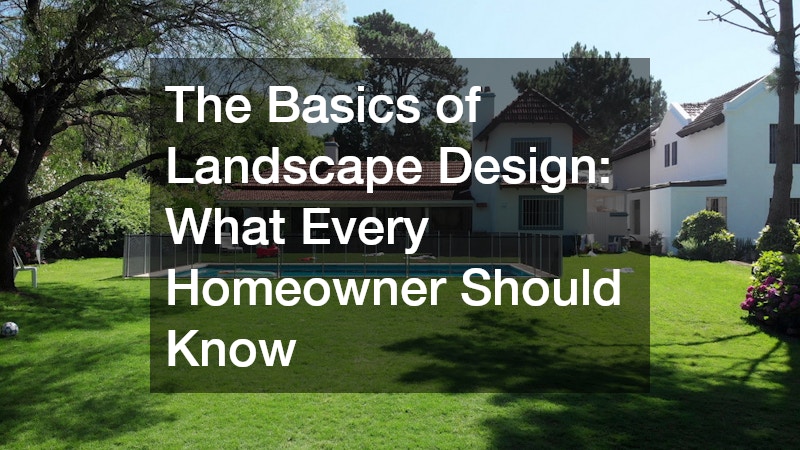Landscape design is an art that involves the planning and creation of outdoor spaces that are both functional and aesthetically pleasing. It combines plant life, architecture, and environmental factors to transform outdoor areas into beautiful and sustainable spaces. For homeowners, understanding the basics of landscape design can empower them to enhance their property’s curb appeal, increase its value, and create a peaceful retreat.
Functionality
Functionality in landscape design ensures that outdoor spaces serve the intended purpose, such as entertainment, relaxation, or gardening. Every element included in the design should enhance the usability of the space. For example, a well-placed patio offers an ideal spot for outdoor dining, while a garden area can support a hobby of cultivating plants.
Planning for functionality involves understanding how you and others will interact with the space. Pathways should direct traffic efficiently, while seating areas should take advantage of shade and sun exposure. By thinking critically about how each area will be used, you can design a landscape that meets all needs.
Aesthetics
Creating visually appealing landscapes is about harmoniously combining color, texture, and form. Strategic plant selection, along with hardscape materials, contributes to the overall beauty of the outdoor space. For instance, using curved pathways can create visual interest and lead the eye naturally through the landscape.
Aesthetics also involve the principles of design, such as balance, proportion, and unity. Balance can be achieved through symmetrical or asymmetrical design choices, while proportion relates to the size relationship between objects. Unity ties the elements together creating a cohesive and harmonious landscape.
Sustainability
Sustainability in landscape design means applying environmentally friendly practices that conserve resources and promote biodiversity. Incorporating native plants that thrive without excessive watering can significantly reduce the need for irrigation. Additionally, the use of rain gardens can help manage stormwater runoff effectively.
By designing landscapes that require minimal upkeep, homeowners can limit the use of pesticides and fertilizers. Creating habitats for local wildlife contributes to biodiversity, supporting birds, butterflies, and beneficial insects. Sustainable designs also consider the long-term impact on the ecosystem, aiming for a balance between human use and nature.
Considering Your Climate Zone
Selecting plants suited to your climate zone is essential for thriving landscapes. Knowing the specific conditions, such as temperature extremes and rainfall patterns, guides the choice of plant varieties. For instance, drought-tolerant plants are ideal for arid climates, reducing reliance on watering.
Gardeners should consult the USDA Plant Hardiness Zone Map to determine the best plants for their regions. Local nurseries and extension services can also provide valuable insights. By understanding local climate factors, homeowners can ensure a robust and resilient garden.
Maintenance Requirements
Understanding maintenance requirements helps in choosing plants that match your lifestyle and time constraints. Low-maintenance plants can save time and resources, particularly for busy homeowners. Options like perennial ground covers require minimal intervention while providing season-long interest.
Factors such as growth rate, pruning needs, and susceptibility to pests play a role in maintenance demands. Homeowners should assess their willingness to engage in regular garden care before selecting plants. Proper plant selection can lead to a landscape that flourishes with minimal effort.
Combining Different Plant Types
A balanced mix of perennials, trees, shrubs, and groundcovers creates a dynamic and appealing plant palette. This combination adds visual interest through varying heights, textures, and colors. Diverse plantings also increase ecological resilience, supporting a range of wildlife species.
Strategically placing various plant types can define different garden zones and enhance spatial hierarchy. Trees provide shade and vertical dimension, while shrubs and perennials fill in the middle ground. Groundcovers can weave all elements together, offering aesthetic continuity.
Assessing Costs and Priorities
Budgeting for a landscape project involves assessing costs and establishing priorities. Begin by identifying the elements crucial to your vision and allocate funds accordingly. This approach helps in focusing on key areas of investment while managing overall expenses.
It’s important to differentiate between immediate needs and optional features that can be added later. Creating a phased plan allows homeowners to spread costs over time. Regular cost tracking helps in managing finances and preventing budget overruns.
High Impact, Low-Cost Solutions
Incorporating high-impact, low-cost elements can enhance landscape appeal without financial strain. Simple features like mulch and edging instantly refresh garden beds and define spaces. Grouping plants with similar needs can optimize resources and create stunning displays.
Creative use of lighting, such as solar-powered fixtures, can transform nightscapes without high energy bills. Repurposing materials or using salvaged items reduces expenses while adding unique character. High-impact solutions focus on enhancing key visual aspects efficiently.
DIY vs. Hiring Professionals
DIY landscape projects can be satisfying and save money, but suitable tasks should fit skills and knowledge. Simple tasks such as planting or mulching are excellent for beginners. However, complex projects like irrigation systems may require expertise to prevent costly errors.
By mastering the basics of landscape design, homeowners can significantly enhance their outdoor spaces. Understanding the core elements, selecting appropriate plants, and budgeting effectively are essential for creating landscapes that not only look beautiful but also stand the test of time. With careful planning and consideration, anyone can transform their yard into a captivating environment that reflects personal style and contributes to a sense of well-being.

